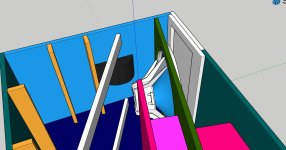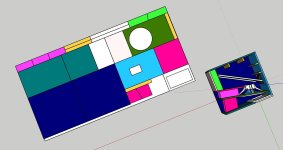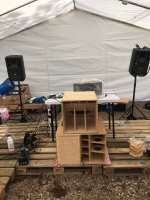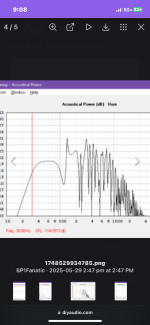After pondering my requirements (and constraints), this configuration is starting to appeal to me...
Before I dive in to learning the amazing CAD tool, can I ask a few questions to give me guidance?
Before I dive in to learning the amazing CAD tool, can I ask a few questions to give me guidance?
- What sort of T/S specs should we be looking for when choosing a driver?
- Could there be compromises/challenges with having a fairly long box (ie 90-120cm) to bring that horn loaded hump down the spectrum?
- Would it be worth looking at filler or damping at the closed end, to address the cancellation notch?
What sort of T/S specs should we be looking for when choosing a driver?
If you are looking to build a "subwoofer", chose size 15" or 18" and start with average driver with aluminium chassis, xmax equal or above 10mm, FS close or below the tuning frequency you targeting (<40Hz), QTS below 0,4. From there you decide the direction you want to improve and how much you want to pay for the driver.
Could there be compromises/challenges with having a fairly long box (ie 90-120cm) to bring that horn loaded hump down the spectrum?
Yes, that hump is defined by the front horn length.
Would it be worth looking at filler or damping at the closed end, to address the cancellation notch?
I think not, I'd go with this design if you are looking for a subwoofer and in this case you going to crossover with tops below the cancellation, if you are looking for a kickbin, it would be better looking for a layout where the driver is not offset with front load horn, like the the models below and choose 12" or 10" driver size.
https://freeloudspeakerplan.rf.gd/pages/wmx.htm
https://freeloudspeakerplan.rf.gd/pages/wlx.htm
All those models are 6th order band pass parallel like manifold. The front horn has no offset and they have different layout and for this reason you can achieve different size ratio, if that is important for your use case. The con for those two models is that you are going to need a removable panel to install the driver.
I have recently been spending a lot of time in Hornresp to come up with a single sub solution for live sound use, crowds up to 200 indoors.
Given the number of segments I needed, I modelled this as an offset driver with a rear vented chamber. Dimensions are 825x825x570. Gross volume is 390 litres.
This appears to give a very good size to response ratio. Excellent sensitivity and useable 40hz response.
Any thoughts, folks?



Given the number of segments I needed, I modelled this as an offset driver with a rear vented chamber. Dimensions are 825x825x570. Gross volume is 390 litres.
This appears to give a very good size to response ratio. Excellent sensitivity and useable 40hz response.
Any thoughts, folks?
Nice! I like the fact that storing the cabs like that don't do cone sag! And the layout looks great !
im always amazed at what some of these combos do with added resonator. Everything is boosted 💚
Last edited:
Any thoughts, folks?
Hello @laxandredeyed
Considering that you don't go the original design, why not building the original layout of MHB where you don't have the offset drive and so improved extension? The alternatives, but little more complex design to build would be WMX and WLX layouts.
https://freeloudspeakerplan.rf.gd/pages/mhb.htm
https://freeloudspeakerplan.rf.gd/pages/wmx.htm
https://freeloudspeakerplan.rf.gd/pages/wlx.htm
If easy to build is your target, I would go Paraflex Type C because cooling is important for subwoofer and you save some money/time in the build process.
https://freeloudspeakerplan.rf.gd/pages/paraflexc.htm
Note: post #7 has the SPL comparison with the paraflex with the same volume as Manifold and as TH. See the link below.
I was not even born at that time 🙂 (81")
Manifold/MTB has a lot of potential witch can be explored more nowadays. Single or multiple per box.
I added in the comparison the Paraflex Type C witch is also easier to build compared to TH but the way it works it need an small Volume penalty to delivery the same low frequency tuning reaching 319L witch is +6%, it improves the upper part of the bandwidth too with the accentuation in the kick area but it's narrow as Tapped Horn, so looks like Manifold/MTB still the winner.
We can add more designs in the comparison if it has the potential to...
Manifold/MTB has a lot of potential witch can be explored more nowadays. Single or multiple per box.
I added in the comparison the Paraflex Type C witch is also easier to build compared to TH but the way it works it need an small Volume penalty to delivery the same low frequency tuning reaching 319L witch is +6%, it improves the upper part of the bandwidth too with the accentuation in the kick area but it's narrow as Tapped Horn, so looks like Manifold/MTB still the winner.
We can add more designs in the comparison if it has the potential to...
@LORDSANSUI build simplicity is a definite consideration here. Playing with the other designs you mentioned, it seems the only improvement in response by avoiding the offset driver is higher in the passband, well above the crossover frequency. I suppose symmetrical loading of the driver would be an advantage.
As for cooling, what are your thoughts on having the reflex ports close to the driver's motor? Would this improve cooling by an appreciable amount?
As for cooling, what are your thoughts on having the reflex ports close to the driver's motor? Would this improve cooling by an appreciable amount?
Ok! I'm back!
I finally got the prototype glued together and took it to a party, to see what it could do. I didn't have time to order the driver i designed it on, so I just put in a random 15" that I took out of a cheap PA reflex sub. I powered it with a shitty old car amp and a truck battery. Probably around 100w at 8ohms. At full volume it distorted a lot, I'm not sure if that was due to the shitty driver or the shitty amp, but sounded really good at 50% volume and even then it was pretty loud and kept the party going all night, so I guess it's pretty efficient.
I tweaked the design a bit, rotating one brace a bit, adding another brace to the back panel and making an access panel, that also doubles as a brace and I guess a small amount of cone correction. I also added a handle.
https://app.sketchup.com/share/tc/n...DLD8LDyiNw7KDszycRMhEXp2KghdNamZKP&source=web
I finally got the prototype glued together and took it to a party, to see what it could do. I didn't have time to order the driver i designed it on, so I just put in a random 15" that I took out of a cheap PA reflex sub. I powered it with a shitty old car amp and a truck battery. Probably around 100w at 8ohms. At full volume it distorted a lot, I'm not sure if that was due to the shitty driver or the shitty amp, but sounded really good at 50% volume and even then it was pretty loud and kept the party going all night, so I guess it's pretty efficient.
I tweaked the design a bit, rotating one brace a bit, adding another brace to the back panel and making an access panel, that also doubles as a brace and I guess a small amount of cone correction. I also added a handle.
https://app.sketchup.com/share/tc/n...DLD8LDyiNw7KDszycRMhEXp2KghdNamZKP&source=web
Attachments
so I just put in a random 15" that I took out of a cheap PA reflex sub
Nice to read your feedback, I hope with the right driver you achieve your targets.
Two things may help to explain the distortion.
1) Check the compression ratio, to do that you divide the SD (Cone area) by the SD, weak cone in general will not resist compression ratio above 2.
2) Check Diaphragm displacement from hornresp, maybe you are achieving xmax below max power.
That helped for sure and was evaluated when we asked David to create the CH2 model as you can see in the attachment. I just didn't had time and energy to offer this particular port shape in the website. Additionally, each user needs to evaluate if the build complexity worth the response improvement.
Note.: After CH2 creation David was able to implement Particle velocity at throat and mouth.
Note.: After CH2 creation David was able to implement Particle velocity at throat and mouth.
Attachments
I haven’t got around to constructing this one yet. I’m currently working on some series tuned bandpass boxes using drivers that didn’t work that well in the manifold design.
Isn't it amazing how some drivers can perform well in a BP6S and perform poorly in a BP6P and vice versa.
Yes, it certainly is. I spend a silly amount of time playing in Hornresp (as I suspect a large number of people here do), and very seldom have I found a driver that performs better in a BP6S than it does in a BP6P. By sheer chance, I pasted a driver into something I had modelled for a different driver and it looked very promising. With much tweaking, I have something now that is almost 3db more sensitive across the same bandwidth as a reflex box the same size!Isn't it amazing how some drivers can perform well in a BP6S and perform poorly in a BP6P and vice versa.
Pick your poison.
Ease of build (no angles), efficient & low, or small & low...Hofmann's Iron Law.





Ease of build (no angles), efficient & low, or small & low...Hofmann's Iron Law.
I thought the whole point of the parallel (3:1) 1/4 wave, or Helmholtz with little compound ‘horn’ designs (or 1/3 offset driver varieties of TL) is to avoid the disaster @ 3 x Fb in those things and all that ringing and junk that duesnt get along with your other speakers?
This isn’t a useful subwoofer(compared to the others)? . The results of that ‘5/4’ and ‘7/4’ resonace are simply too nasty to bother with trying to eliminate/crossover through and the lower resonaces might be a bit ‘overdamped’? The problem is the ‘high compression ratio’ and long skinny pipe relative to the motorforce ?
This isn’t a useful subwoofer(compared to the others)? . The results of that ‘5/4’ and ‘7/4’ resonace are simply too nasty to bother with trying to eliminate/crossover through and the lower resonaces might be a bit ‘overdamped’? The problem is the ‘high compression ratio’ and long skinny pipe relative to the motorforce ?
Attachments
Last edited:
Pick your poison.
Ease of build (no angles), efficient & low, or small & low...Hofmann's Iron Law.
View attachment 1466571
View attachment 1466572
View attachment 1466573
View attachment 1466574
View attachment 1466575
1st option!!
- Home
- Loudspeakers
- Subwoofers
- Case for Discussion - Would a Single driver Manifold/MTB be better than Tapped Horn?



